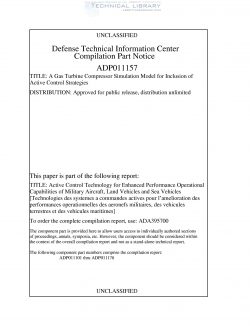DTIC-AD-P011157
- Version
- 171 Downloads
- 777.32 KB File Size
- 1 File Count
- March 5, 2017 Create Date
- March 5, 2017 Last Updated
A Gas Turbine Compressor Simulation Model for Inclusion of Active Control Strategies

The need for a wider operability range of modern compressors for gas turbine applications is the "prime mover" for a large research effort that is nowadays undertaken in many international laboratories, organisations, companies and universities. This effort is both experimental and computational. The overall behaviour of a gas turbine compressor outside its stability range has been understood and can be modelled using a simplified lumped parameters approach (Greitzer, 1976, Baghdadi ct al., 1982). Many detailed experimental analysis are nowadays focused on stall inception (Day et al, 1999, Camp-Day 1998, Spakovsky et al., 1999) to understand the fluid- dynamic mechanism of formation and to be able to improve its computational modelling. On the other hand the computational models for the analysis of a multistage compressor in steady flow (through- flow or 3D Navier-Stokes) are not directly applicable to unsteady Oransient or dynamic) flows because they are either inappropriate (standard through-flow) or they require an excessive computational effort (3D Navier-St0kes). The most simplified approach is the zero dimensional lumped parameter technique that considers each component Of the compression system as a node and by wriling (he balance for mass flow, momentum and energy it results in a set Of differential equations to be solved with respect to time (Greitzer, 1976, Massardo ct al. 1989, Botros, 1994). The one dilnensional model for the analysis Of the unsteady flow in a compression system can be a good compromise between the accuracy in capturing the main system performances and the computational effort. This approach introduces the conservation equations (continuity, momentum and energy) for a continuum and, after a domain discretization, are integrated using a time-marching technique; the effect of blades, mass bleeds, friction etc.... are introduced as external body forces. This technique has been considered and a time- marching technique, previously developed for 21)/3D turbomachinery flows (Cravero. 1995), has been converted in ID form with the insertion of the appropriate external forces to model the dynamic of the compression system. The ID lime-marching approach is preferred over the lumped parameter technique, because it allows the analysis
| File | Action |
|---|---|
| DTIC-AD-P011157 A Gas Turbine Compressor Simulation Model for Inclusion of Active Control Strategies.pdf | Download |

Comment On This Post